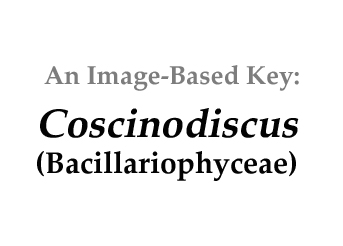|
Home / Diatoms / centric / unicells / Coscinodiscus |
||||
|
|
||||
|
|
||||
|
Click on images for larger format |
||||
Name derivation: |
||||
|
From the Greek koskinon, a sieve, and diskos, a disc. |
||||
|
Classification: |
||||
Coscinodiscus Ehrenberg 1839; 89 of 1117 species descriptions are currently accepted taxonomically (Guiry and Guiry 2013).Order Coscinodiscales; Family Coscinodiscaceae |
||||
Morphology: |
||||
|
Frustules are usually disc-like in shape and are always shorter vertically than horizontally. In valve view most species have cells that are circular, but can also have an irregular outline or be elliptical. Ornamentation varies from minute punctae to heavy shading that can be irregularly distributed, or radiate towards the end of the cell body. Some species have small denticulations (teeth-like parts) around the edges of the cell. |
||||
Similar genera: |
||||
|
Cyclotella: differs in its ornamentation in valve view. It has two distinct regions of ornamentation. |
||||
Habitat: |
||||
|
Marine species with over 450 species found free floating in the oceans. One freshwater species has been found: C. subtilis Ehr. |
||||
References: |
||||
|
Ehrenberg, C.G. 1839. Über die Bildung der Kreidefelsen und des Kreidemergels durch unsichtbare Organismen. Abhandlungen der Königlichen Akademie der Wissenschaften zu Berlin1838: 59-147, pls I-IV, tables 1, 2. Guiry, M.D. & Guiry, G.M. 2013. AlgaeBase. World-wide electronic publication, National University of Ireland, Galway. http://www.algaebase.org; searched on 19 September 2013. Hasle, G et al. Identifying Marine Phytoplankton. Academic Press (1997). |
||||















